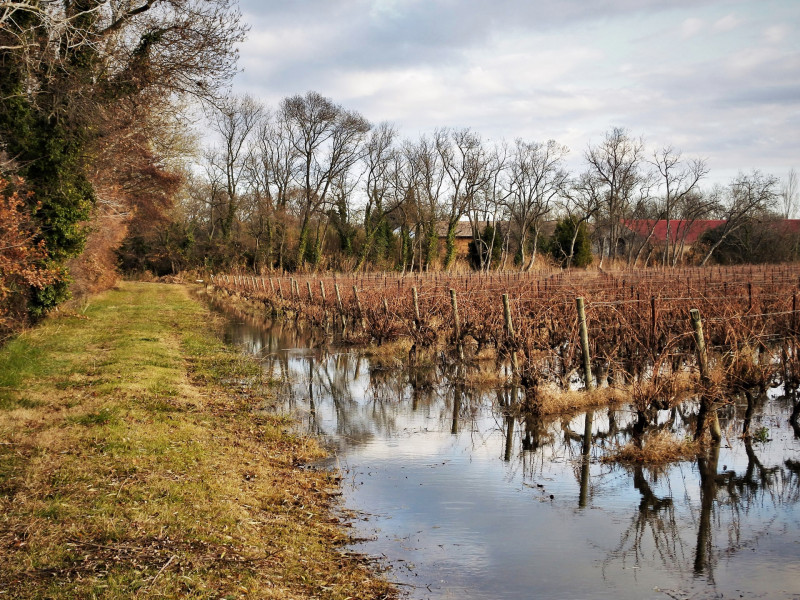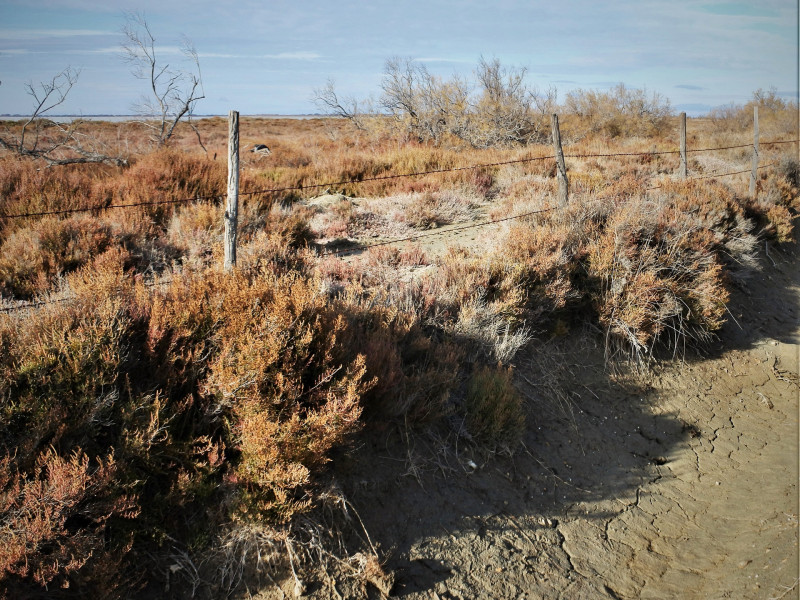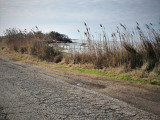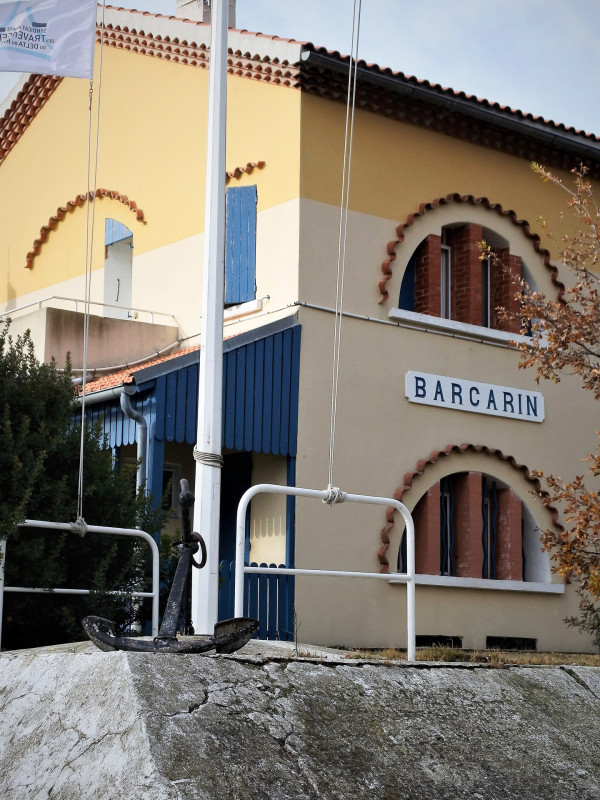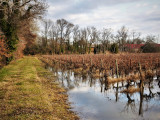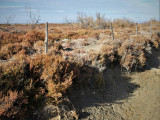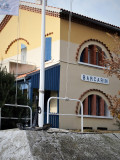The vineyard of Camargue, the wines of the delta
LeisurePresentation
A tourist route around wine and the Camargue. To be followed with your vehicle, over a day.
Among the landscapes, marshes, rice fields and beaches where the bulls of breeding côtoient the horses and the pink flamingos.
In the heart of the Camargue Regional Natural Park, this territory distills along the roads and paths of wine estates with original grape varieties, often enhanced by cultural and gastronomic events inviting you to stop for a while. When an unequalled natural ecosystem is supported by unprecedented agricultural talents, the visitor should not sulk in his pleasure.
Musée d'Arles Antiques: In 2004, the museum team was far from thinking that the few planks that appeared in the troubled waters of the Rhone concealed a 31-meter long boat, complete in all its parts, and that it would find its place in the Musée départemental Arles Antique in 2013. With this exceptional operation, the Roman barge Arles-Rhône 3 joins the very closed club of boats found complete (or almost) in excavation, saved and installed in a museum.
The river-sea trade is of primary importance, since it shows the essential role played by the city, crossroads of Roman routes and first stop for ships sailing up the Rhone. The amphorae, the most common containers transported on the river, are exhibited chronologically along the barge, from the Early Empire to Late Antiquity.
Leaving the parking lot of the Musée Départemental d'Arles Antique, turn right onto the Avenue de la 1ère Division Française Libre. At the first traffic circle, turn left to join the D35 in the direction of Mas Thibert.
Before arriving at Mas Thibert, the first of the southernmost wineries along the Rhone :
Mas de l'Attilon: Legend has it that Saint Louis, leaving for the crusades, would have rested under the oaks of Attilon. Myth or reality? It doesn't matter! The story argues for a visit of the domain and a meeting with its owner. Renaud de Roux is an organic winegrower who makes reds, rosés and whites, which have been rewarded with numerous distinctions.
The village of Mas-Thibert is located between the Rhône river and the canal from Arles to Bouc. This territory used to belong to the Hospitallers of Saint-Jean-de-Jérusalem. In the sixties, following the Algerian war, a community of harkis came to settle there. It is now one of the largest in France.
The Conservatoire du littoral has developed a domain of natural spaces open to the public, the Marais du Vigueirat, rich in flora and fauna. Crossed by the Via Rhôna, the bicycle path linking the Swiss Alps to the Mediterranean, the village of Mas-Thibert is the only existing bicycle stop between the cities of Arles and Port-Saint-Louis-du-Rhône. A parking lot is dedicated to cars for people who want to do only one section of the Via Rhôna.
Continue your journey in the direction of Port St Louis du Rhône. Next stop is the Domaine Isle St Pierre:
Discover the biodiversity of Isle Saint Pierre through a walk along the Rhône, in the heart of the vineyards. Julien, 4th generation winegrower, will share with you the values and commitments of the Henry family for a sustainable viticulture.
For the 90th anniversary of the domain, the Isle Saint Pierre team will see its work recognized by obtaining the VDD label (Vignerons en Développement Durable).
After crossing the Rhone navigation canal at the Port of Fos-sur-Mer, you will
Continue to Port St Louis du Rhône and its Napoleon beach.
Port-Saint-Louis du Rhône is the last town on the Rhône. The formation of the Rhone delta over the centuries has continuously shaped the appearance of its mouth.
You can access the mouth from the Napoleon beach: By walking west of the parking lot, you will reach a rocky outcrop.
The mouth of the river is a 20 minute walk away, still heading west.
Turn around to cross the Rhône with the Baccarin ferry.
After crossing the Rhone you can stop at Salin de Giraud:
The exploitation of salt is ancient. But it was at the end of the 19th century that the town underwent a particular development with the establishment of two companies linked to this activity, which also led to a strong migration of labor.
The vast area of the salt works is of great ecological and landscape interest.
Leave the village of Salin de Giraud on the RD36 towards Arles. After 2km turn left on the RD36c, then take the RD36b towards the Etang de Vaccarès.
Covering more than 13000 ha in the heart of the Camargue, the National Nature Reserve of Camargue includes the Vaccarès pond and two "lower ponds" (Lion and Dame): it is one of the largest wetland reserves in Europe. Its vast territory of wild natural environments consisting of a mosaic of ponds, lagoons, dunes and fossils, beaches and sansouires in one piece, is located on the municipalities of Arles and Saintes Maries de la mer, and enjoys full protection.
Under its apparent dryness, the sansouire is a very welcoming environment for the fauna and the flora, and constitutes flat and deserted immensities between the sea and the lagoons. Its vegetation is green, in dense and scattered clumps. In summer, this landscape is very arid, it floods in winter, to be reborn as mudflats in spring and autumn.
Stop at La Capélière to discover this Camargue landscape.
Continue to the hamlet of Villeneuve. Turn right on the RD37 in the direction of Salin de Giraud. At the intersection with the RD36 turn right to reach the Domaine de Beaujeu 800m further on.
Beaujeu is the only estate in the Arles region that has kept the balance of the past. For five generations, the owners have perpetuated a diversified agriculture where viticulture, cereals, meadows and protected areas are mixed. The domain is certified in organic farming since 1974.
After discovering the Domain, turn back on the RD36 towards Arles and turn left again 800m further towards Villeneuve.
Drive for 1km and turn right onto the Route de Romieu which takes you through landscapes of large crops to the RD36b, and following it south, towards the Domaine de Valériole.
In the setting of an authentic Camargue farmhouse, in Gageron, the Michel family, represented by their two brothers Jean-Paul and Patrick, continue the family work, started in 1950.
To the first comes the cereals (including rice) to the second, the vineyard (22 hectares), exploited in bio.
On the menu, two ranges of wines: Le Mas de Valériole and Le Domaine Saint-Vincent, each declined in three colors.
The omnipresence of rice in the Camargue is mainly due to its role in desalinating the land. Rice is the backbone of the agricultural system in the Camargue. The model works like this: three years of rice cultivation that sufficiently desalts the soil but gradually leads to its infestation by weeds. A rainfed crop is then introduced, which can be durum wheat, rapeseed, sorghum, sunflower, etc. After three years, the salinity reappears and it is necessary to return to rice cultivation.
To understand the landscapes of the Camargue and in particular the historical importance of viticulture, go to the Musée de Camargue.
To do this, when leaving the Mas de Valériole, turn right onto the RD36b to Gageron. In the hamlet take the small road from Bouchaud to Gagéron.
A stop for wine tasting can be made at the Domaine de Bouchaud:
When monastic life rubs shoulders with the culture of the vine, the experience is worthwhile. Here we are in the lands of the Benedictine monks installed in the nearby Notre-Dame-des-Champs priory.
To join the RD570 in direction of Stes Maries de Mer take a shortcut by the road of Bouchaud and the small road of Ste Cécile.
Turn left in the direction of Stes Maries de la Mer. After a few kilometers you will arrive at the Camargue Museum.
The Camargue museum, a must-see, retraces the wine-making adventure of the delta.
Between 1880 and the Second World War, the Camargue experienced an extraordinary wine-growing adventure. Most of the farmhouses in the Camargue still have, in addition to the old sheepfold, a cellar, sometimes dilapidated, but whose imposing dimensions still attest to its past importance. These huge cellars bear witness to a golden age that saw Camargue agriculture seize an opportunity - the resistance of local vines to phylloxera thanks to winter flooding - and turn it into a strength thanks to a massive injection of capital and technology.
...and you can see for yourself.
The house of Rice is located at Mas de la vigne in Albaron.
To get there: leave the RD570 in Albaron by taking the RD37 on the right.
About 1km after the hamlet turn left on the small red road of Figares.
The Maison du Riz is not a museum but an educational space presenting the evolution of rice growing from its beginnings in the Camargue to the present day. Three spaces have been created: a space dedicated to the specific material of rice growing, a space dedicated to the rice grain and its different stages of transformation, a store corner.
This small road follows the meanders of the Petit Rhône up to the RD572n.
Turn right towards Arles. Drive about 2km and turn left on the road 144 called "chemin vicinal de Cazeneuve à Rigaudon".
You will pass the abandoned buildings of the Caves Buehler, another testimony of the wine industry in Camarque.
Continue to the Mas de Rey, the last stop on our journey.
Everything leads us to believe that the Mas was part of the rural estate of the Order of the Temple, the chapel having been erected on the foundations of a temple, the dimensions testify to this.
In the heart of the Camargue Regional Natural Park, this territory distills along the roads and paths of wine estates with original grape varieties, often enhanced by cultural and gastronomic events inviting you to stop for a while. When an unequalled natural ecosystem is supported by unprecedented agricultural talents, the visitor should not sulk in his pleasure.
Musée d'Arles Antiques: In 2004, the museum team was far from thinking that the few planks that appeared in the troubled waters of the Rhone concealed a 31-meter long boat, complete in all its parts, and that it would find its place in the Musée départemental Arles Antique in 2013. With this exceptional operation, the Roman barge Arles-Rhône 3 joins the very closed club of boats found complete (or almost) in excavation, saved and installed in a museum.
The river-sea trade is of primary importance, since it shows the essential role played by the city, crossroads of Roman routes and first stop for ships sailing up the Rhone. The amphorae, the most common containers transported on the river, are exhibited chronologically along the barge, from the Early Empire to Late Antiquity.
Leaving the parking lot of the Musée Départemental d'Arles Antique, turn right onto the Avenue de la 1ère Division Française Libre. At the first traffic circle, turn left to join the D35 in the direction of Mas Thibert.
Before arriving at Mas Thibert, the first of the southernmost wineries along the Rhone :
Mas de l'Attilon: Legend has it that Saint Louis, leaving for the crusades, would have rested under the oaks of Attilon. Myth or reality? It doesn't matter! The story argues for a visit of the domain and a meeting with its owner. Renaud de Roux is an organic winegrower who makes reds, rosés and whites, which have been rewarded with numerous distinctions.
The village of Mas-Thibert is located between the Rhône river and the canal from Arles to Bouc. This territory used to belong to the Hospitallers of Saint-Jean-de-Jérusalem. In the sixties, following the Algerian war, a community of harkis came to settle there. It is now one of the largest in France.
The Conservatoire du littoral has developed a domain of natural spaces open to the public, the Marais du Vigueirat, rich in flora and fauna. Crossed by the Via Rhôna, the bicycle path linking the Swiss Alps to the Mediterranean, the village of Mas-Thibert is the only existing bicycle stop between the cities of Arles and Port-Saint-Louis-du-Rhône. A parking lot is dedicated to cars for people who want to do only one section of the Via Rhôna.
Continue your journey in the direction of Port St Louis du Rhône. Next stop is the Domaine Isle St Pierre:
Discover the biodiversity of Isle Saint Pierre through a walk along the Rhône, in the heart of the vineyards. Julien, 4th generation winegrower, will share with you the values and commitments of the Henry family for a sustainable viticulture.
For the 90th anniversary of the domain, the Isle Saint Pierre team will see its work recognized by obtaining the VDD label (Vignerons en Développement Durable).
After crossing the Rhone navigation canal at the Port of Fos-sur-Mer, you will
Continue to Port St Louis du Rhône and its Napoleon beach.
Port-Saint-Louis du Rhône is the last town on the Rhône. The formation of the Rhone delta over the centuries has continuously shaped the appearance of its mouth.
You can access the mouth from the Napoleon beach: By walking west of the parking lot, you will reach a rocky outcrop.
The mouth of the river is a 20 minute walk away, still heading west.
Turn around to cross the Rhône with the Baccarin ferry.
After crossing the Rhone you can stop at Salin de Giraud:
The exploitation of salt is ancient. But it was at the end of the 19th century that the town underwent a particular development with the establishment of two companies linked to this activity, which also led to a strong migration of labor.
The vast area of the salt works is of great ecological and landscape interest.
Leave the village of Salin de Giraud on the RD36 towards Arles. After 2km turn left on the RD36c, then take the RD36b towards the Etang de Vaccarès.
Covering more than 13000 ha in the heart of the Camargue, the National Nature Reserve of Camargue includes the Vaccarès pond and two "lower ponds" (Lion and Dame): it is one of the largest wetland reserves in Europe. Its vast territory of wild natural environments consisting of a mosaic of ponds, lagoons, dunes and fossils, beaches and sansouires in one piece, is located on the municipalities of Arles and Saintes Maries de la mer, and enjoys full protection.
Under its apparent dryness, the sansouire is a very welcoming environment for the fauna and the flora, and constitutes flat and deserted immensities between the sea and the lagoons. Its vegetation is green, in dense and scattered clumps. In summer, this landscape is very arid, it floods in winter, to be reborn as mudflats in spring and autumn.
Stop at La Capélière to discover this Camargue landscape.
Continue to the hamlet of Villeneuve. Turn right on the RD37 in the direction of Salin de Giraud. At the intersection with the RD36 turn right to reach the Domaine de Beaujeu 800m further on.
Beaujeu is the only estate in the Arles region that has kept the balance of the past. For five generations, the owners have perpetuated a diversified agriculture where viticulture, cereals, meadows and protected areas are mixed. The domain is certified in organic farming since 1974.
After discovering the Domain, turn back on the RD36 towards Arles and turn left again 800m further towards Villeneuve.
Drive for 1km and turn right onto the Route de Romieu which takes you through landscapes of large crops to the RD36b, and following it south, towards the Domaine de Valériole.
In the setting of an authentic Camargue farmhouse, in Gageron, the Michel family, represented by their two brothers Jean-Paul and Patrick, continue the family work, started in 1950.
To the first comes the cereals (including rice) to the second, the vineyard (22 hectares), exploited in bio.
On the menu, two ranges of wines: Le Mas de Valériole and Le Domaine Saint-Vincent, each declined in three colors.
The omnipresence of rice in the Camargue is mainly due to its role in desalinating the land. Rice is the backbone of the agricultural system in the Camargue. The model works like this: three years of rice cultivation that sufficiently desalts the soil but gradually leads to its infestation by weeds. A rainfed crop is then introduced, which can be durum wheat, rapeseed, sorghum, sunflower, etc. After three years, the salinity reappears and it is necessary to return to rice cultivation.
To understand the landscapes of the Camargue and in particular the historical importance of viticulture, go to the Musée de Camargue.
To do this, when leaving the Mas de Valériole, turn right onto the RD36b to Gageron. In the hamlet take the small road from Bouchaud to Gagéron.
A stop for wine tasting can be made at the Domaine de Bouchaud:
When monastic life rubs shoulders with the culture of the vine, the experience is worthwhile. Here we are in the lands of the Benedictine monks installed in the nearby Notre-Dame-des-Champs priory.
To join the RD570 in direction of Stes Maries de Mer take a shortcut by the road of Bouchaud and the small road of Ste Cécile.
Turn left in the direction of Stes Maries de la Mer. After a few kilometers you will arrive at the Camargue Museum.
The Camargue museum, a must-see, retraces the wine-making adventure of the delta.
Between 1880 and the Second World War, the Camargue experienced an extraordinary wine-growing adventure. Most of the farmhouses in the Camargue still have, in addition to the old sheepfold, a cellar, sometimes dilapidated, but whose imposing dimensions still attest to its past importance. These huge cellars bear witness to a golden age that saw Camargue agriculture seize an opportunity - the resistance of local vines to phylloxera thanks to winter flooding - and turn it into a strength thanks to a massive injection of capital and technology.
...and you can see for yourself.
The house of Rice is located at Mas de la vigne in Albaron.
To get there: leave the RD570 in Albaron by taking the RD37 on the right.
About 1km after the hamlet turn left on the small red road of Figares.
The Maison du Riz is not a museum but an educational space presenting the evolution of rice growing from its beginnings in the Camargue to the present day. Three spaces have been created: a space dedicated to the specific material of rice growing, a space dedicated to the rice grain and its different stages of transformation, a store corner.
This small road follows the meanders of the Petit Rhône up to the RD572n.
Turn right towards Arles. Drive about 2km and turn left on the road 144 called "chemin vicinal de Cazeneuve à Rigaudon".
You will pass the abandoned buildings of the Caves Buehler, another testimony of the wine industry in Camarque.
Continue to the Mas de Rey, the last stop on our journey.
Everything leads us to believe that the Mas was part of the rural estate of the Order of the Temple, the chapel having been erected on the foundations of a temple, the dimensions testify to this.
Opening period (s)All year round.
Practical information
- Activities :
- Tourist routes
- Tourist itinerary :
- Tourist itinerary
- Park :
- Camargue Regional Nature Park
Tarifs
Free access.
Download
Contact
The vineyard of Camargue, the wines of the delta
Presqu'Ile du Cirque Romain
13200
Arles
Destination
Le vignoble de Camargue, les vins du delta
Presqu'Ile du Cirque Romain
13200
Arles
GPS coordinates
Latitude : 43.672466
Longitude : 4.616425



